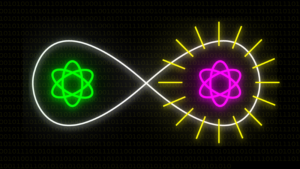GS3 – Science & Technology

Context:
In a significant advancement, IIT-Delhi and DRDO jointly demonstrated Quantum Key Distribution (QKD) in free-space communication across a distance exceeding 1 km. The system achieved a secure key rate of 240 bits per second with a Quantum Bit Error Rate (QBER) of less than 7%.
- Secure Key Rate: Number of secure bits generated per second.
- QBER: Indicates errors in the measurement of photon states, expressed as a percentage.
Global Benchmark:
In 2021, China established the world’s first large-scale quantum communication network, a 4,600 km space-to-ground link, using the Micius satellite.
Understanding Quantum Communication:
Quantum communication leverages quantum physics principles—notably entanglement and superposition—to ensure extremely secure data transmission.
- Photon-Based Encoding: Information is encoded in the quantum states of photons, unlike binary bits in classical communication.
- Entanglement-Driven Security: Utilizes pairs of entangled photons whose states are interlinked, ensuring secure, real-time coordination between parties.
- Quantum Key Distribution (QKD): A core technique to generate tamper-proof encryption keys.
- Superposition Principle: Allows photons to exist in multiple states until measured, adding complexity to interception.
Core Concepts in Quantum Mechanics:
- Quantum Entanglement:
When two photons are entangled, measuring one instantly determines the state of the other, regardless of distance. This phenomenon violates classical physics norms (non-locality).- Created by: Parametric down-conversion, using crystals to produce entangled pairs.
- Property Shared: Usually polarisation.
- Quantum Superposition:
A quantum particle can exist in more than one state simultaneously until an observation collapses it into one.
Quantum Key Distribution (QKD):
A specialized method to exchange secure encryption keys, QKD doesn’t encrypt data directly but protects the key exchange, enabling secure systems like AES.
- Mechanism: Qubits (quantum bits) are transmitted via photons, encoding information in their quantum states such as polarisation.
- Encryption Standard Used: Advanced Encryption Standard (AES), a symmetric cryptographic method used in secure platforms like UPI.
Types of QKD:
| Feature | Prepare-and-Measure QKD | Entanglement-Based QKD |
| Photon Source | Sender sends individually prepared photons | Uses entangled photon pairs |
| Security Basis | Trust-based on device reliability | Device-independent, stronger security |
| Complexity | Simpler, easier to implement | More complex due to entanglement |
| Error Resistance | More prone to device-related errors | Better resistance to side-channel attacks |
| Scalability | Compatible with current systems | Limited scalability due to entanglement |
Applications of Quantum Communication:
- Military: Ensures secure transmission for precision strikes, UAVs, and surveillance systems.
- Banking & Digital Payments: Safeguards platforms like UPI against cyber theft.
- Healthcare: Secures digital health records and telemedicine data.
- Smart Infrastructure: Protects data in smart grids and urban IoT systems.
- E-Governance: Shields citizen data in platforms like Digital India.
Advantages:
- Unhackable Systems: Instantly detects interception attempts.
- Satellite-Enabled Security: Supports global, space-based secure communication.
- Future-Proof: Immune to hacking by future quantum computers.
- Integrity Protection: Ensures that transmitted data remains intact.
- Supports Quantum Internet: Paves the way for next-generation secure networks.
Challenges:
- Range Constraints: Photon loss reduces effective communication distance.
- Cost Barriers: High cost of quantum detectors and infrastructure.
- Infrastructure Compatibility: Not compatible with conventional telecom networks.
- Lack of Global Standards: Absence of uniform international protocols—e.g., India vs China systems.
- Error Management: High Quantum Bit Error Rate can degrade security and efficiency.




